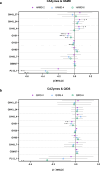Gut microbial CAZymes markers for depression
- PMID: 38443364
- PMCID: PMC10914822
- DOI: 10.1038/s41398-024-02850-x
Gut microbial CAZymes markers for depression
Abstract
Major depressive disorder (MDD) is a serious mental illness, characterized by disturbances of gut microbiome, it is required to further explore how the carbohydrate-active enzymes (CAZymes) were changed in MDD. Here, using the metagenomic data from patients with MDD (n = 118) and heath controls (HC, n = 118), we found that the whole CAZymes signatures of MDD were significantly discriminated from that in HC. α-diversity indexes of the two groups were also significantly different. The patients with MDD were characterized by enriched Glycoside Hydrolases (GHs) and Polysaccharide Lyases (PLs) relative to HC. A panel of makers composed of 9 CAZymes mainly belonging to GHs enabled to discriminate the patients with MDD and HC with AUC of 0.824. In addition, this marker panel could classify blinded test samples from the two groups with an AUC of 0.736. Moreover, we found that baseline 4 CAZymes levels also could predict the antidepressant efficacy after adjusted confounding factors and times of depressive episode. Our findings showed that MDD was associated with disturbances of gut CAZymes, which may help to develop diagnostic and predictive tools for depression.
© 2024. The Author(s).
Conflict of interest statement
The authors declare no competing interests.
Figures



Similar articles
-
Landscapes of bacterial and metabolic signatures and their interaction in major depressive disorders.Sci Adv. 2020 Dec 2;6(49):eaba8555. doi: 10.1126/sciadv.aba8555. Print 2020 Dec. Sci Adv. 2020. PMID: 33268363 Free PMC article.
-
Differences in bacterial taxa between treatment-naive patients with major depressive disorder and non-affected controls may be related to a proinflammatory profile.BMC Psychiatry. 2024 Jan 31;24(1):84. doi: 10.1186/s12888-024-05547-z. BMC Psychiatry. 2024. PMID: 38297265 Free PMC article.
-
Young Adults with Major Depression Show Altered Microbiome.Neuroscience. 2023 Jul 1;522:23-32. doi: 10.1016/j.neuroscience.2023.05.002. Epub 2023 May 9. Neuroscience. 2023. PMID: 37169166
-
Carbohydrate-active enzymes (CAZymes) in the gut microbiome.Nat Rev Microbiol. 2022 Sep;20(9):542-556. doi: 10.1038/s41579-022-00712-1. Epub 2022 Mar 28. Nat Rev Microbiol. 2022. PMID: 35347288 Review.
-
Antidepressants, antimicrobials or both? Gut microbiota dysbiosis in depression and possible implications of the antimicrobial effects of antidepressant drugs for antidepressant effectiveness.J Affect Disord. 2017 Jan 15;208:22-32. doi: 10.1016/j.jad.2016.09.012. Epub 2016 Sep 28. J Affect Disord. 2017. PMID: 27744123 Review.
References
MeSH terms
Grants and funding
LinkOut - more resources
Full Text Sources
Molecular Biology Databases

